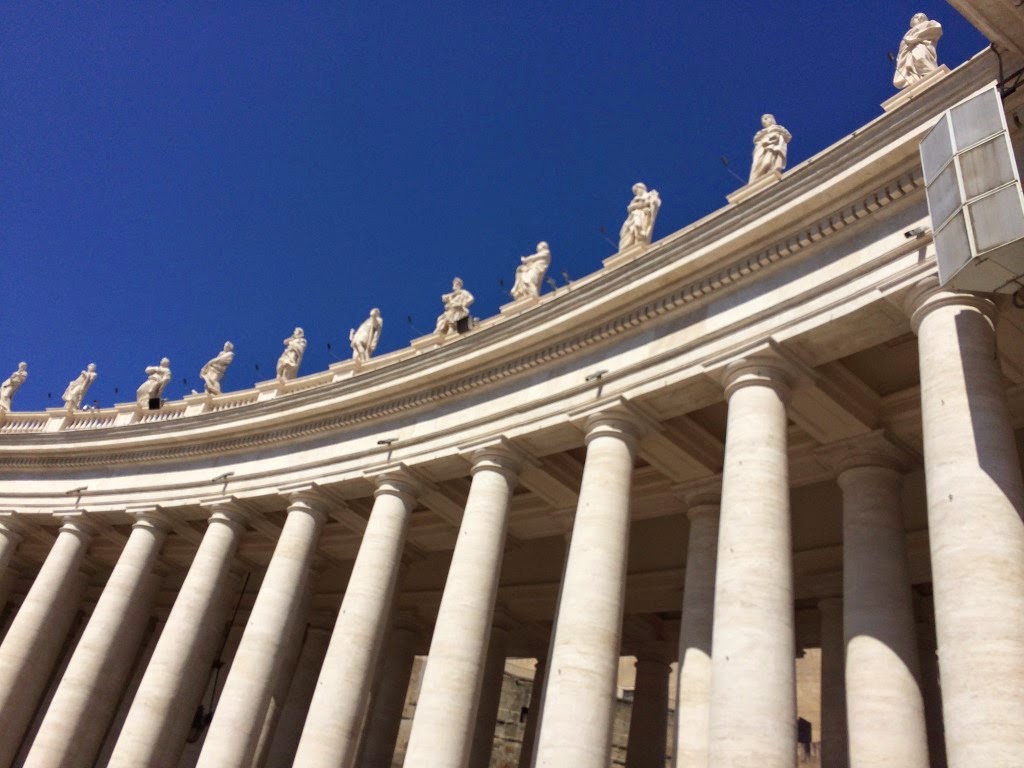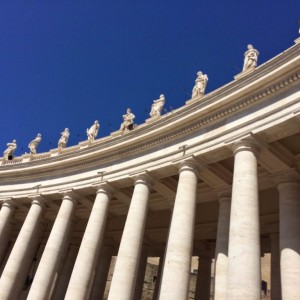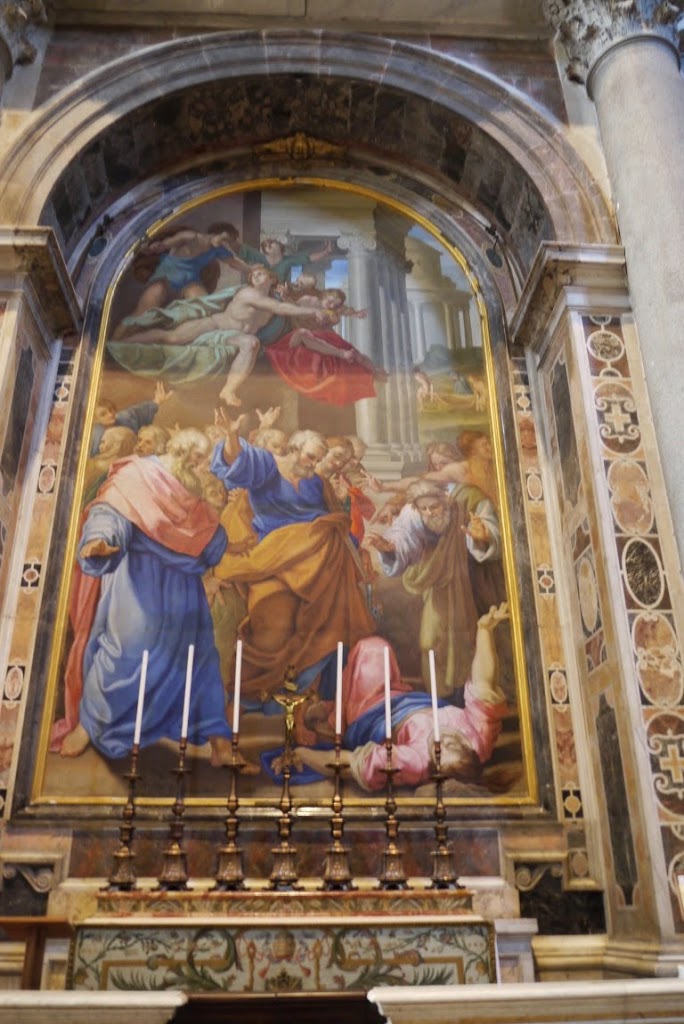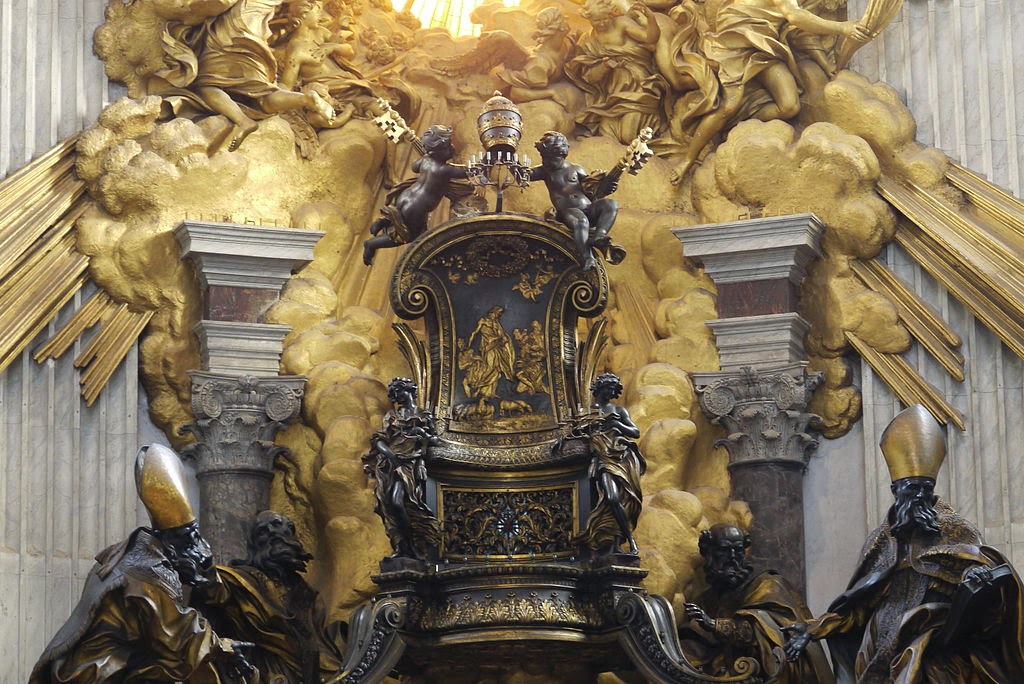 |
| St. Peter’s Square |
St. Peter’s Basilica is one of the largest, most famous, and most beautiful churches in the world. Rightly has it been called “the greatest of all churches of Christendom.” Although the pope’s cathedral is actually St. John Lateran, St. Peter’s Basilica is the church typically associated with the papacy.
After all, it’s built on the Tomb of St. Peter, the first pope, and the Basilica was something of a symbol of the Reformation. After the original St. Peter’s Basilica started to show wear and tear, a larger and more beautiful church was designed. It took over a century to complete (beginning prior to the Reformation, and being completed in 1626), and it was the sale of indulgences to finance the rebuilding of St. Peter’s that sparked the Reformation.
So for both better and for worse, St. Peter’s came to represent the papacy during the Reformation period. Given this, you might expect it to boast of papal power, with grand declarations of the primacy of St. Peter and his successors. The truth is much more surprising. Just as the Gospel of Matthew couples Christ’s establishment of the Church on Peter (Matthew 16:17-19) with a quick reminder of Peter’s unworthiness for the task (Mt. 16:21-23), St. Peter’s Basilica is filled with reminders of the pope’s unworthiness, and our own. Let me give you four examples:
While the Transfiguration is one of the first things that a visitor sees upon entering St. Peter’s, that’s not necessarily the case for priests. If they’re celebrating Mass, chances are, they’re entering the Basilica from the sacristy. And what are they greeted with upon entering? The so-called “Altar of the Lie.” It’s a side altar with a massive mosaic above it by Roncalli, depicting the death of Sapphira (Acts 5:1-11).
If you don’t recall, let me recap: Ananias and his wife Sapphira sell a piece of property, and go to present the proceeds to St. Peter and the Apostles. Secretly (or not so secretly, as we’re dealing with God here), they decided to keep some of the money back. They then lie to St. Peter, claiming that this was the full amount. They are both struck dead on the spot, and the last words Ananias hears are St. Peter saying, “you have not lied to men but to God” (Acts 5:4). Think about what is being said to the priest as he is about to celebrate Mass: you’ve promised God everything, and are now about to celebrate at His Altar. Don’t hold anything back.
In the aspe of the Basilica, in the center of the back wall, is one of the most famous parts of St. Peter’s: the Cathedra Petri (Chair of Peter) by Bernini. It’s built around an actual 9th century papal throne (located inside the bronze throne you see here). The Cathedra, or “Chair,” represented the “seat of power” in antiquity and in Scripture, and it’s the root of words like “Cathedral.” Christ speaks of the Pharisees having binding authority (despite their sinfulness) because they taught from “the Chair of Moses” (Matthew 23:2). Because of this, He instructed His followers to “practice and observe whatever they tell you, but not what they do; for they preach, but do not practice” (Mt. 23:3). That’s some pretty loaded imagery, because it acknowledges that someone — even the pope — might be totally unworthy to wield the authority God has given them.
Around the Chair of St. Peter, we see four men using ropes to holding up the seat. These are the four of the Doctors of the Church: Saints Ambrose and Augustine from the West, and Saints Athanasius and John Chrysostom from the East. These four men bravely shepherded, defended, taught, and strengthened the Church in difficult periods, as she faced persecution from without and heresy from within. Yet if you look more closely, you’ll see that they’re not really holding up the Chair of Peter:
The ropes lie slack in their hands. Instead, the Chair is actually being held up by the golden rays emanating from the Holy Spirit. The meaning is clear: in the final analysis, the papacy isn’t protected because we have holy popes, or brilliant theologians, or clever apologists, or even great Saints. The papacy is protected because it’s upheld by the Holy Spirit, regardless of whether the men sitting in the Chair (or helping to uphold it) are brilliant or stupid, holy or wicked.
Finally, we come to another of the most famous statues in St. Peter’s (and indeed, the world). The statue is St. Peter Enthroned. It’s believed to be the work of the 13th century sculptor Arnolfo di Cambio, but some scholars date it back as far as the fifth century.
Whatever the case, it’s clearly of St. Peter sitting on a papal cathedra, holding the Keys to the Kingdom in one hand, with the other hand raised in blessing. But there’s a weird feature: the arm holding the keys is in a sling. Why? Because the Keys to the Kingdom of God are too much for any man, apart from Divine assistance. St. Peter can’t bear the Keys on his own, and the sling represents the way that he is upheld by Someone stronger than himself.
All of this art exists to proclaim the same message: the Church is founded on Peter and the Apostles, defended and strengthened by the Doctors of the Church, and spread throughout the world by each one of us. Yet Christ doesn’t need Peter or the Apostles or the Doctors, just as He doesn’t need us.
It may not sound like it, but that’s Good News. Why? Because none of us are capable, on our own, of fulfilling the good works that God has called us to. We can’t make it on our own, and if everything relied upon else, it’d be a disaster. Instead, we need Him. We – priests and laity alike – need to turn over everything to Him, holding nothing back, and entrusting all to the Holy Spirit.






Awesome!
But you are a chosen generation, a royal priesthood, a holy nation, a purchased people, that you may declare his virtues, who hath called you out of darkness into his marvellous light.
Rome is our Capital and do whatever you have to do to travel there at least once in your life
I will go on a Pilgrimage to Rome in the future (God willing).
Joe, fantastic post as always. May God bless you and your ministry.
Joe, you ought to compile your posts in book form. You’ll never know: your stuff could be placed in libraries around the world; to be read by scholars (in say 500 years time). The Magisterium could call you a doctor of the Church; who spread the Gospel in a secularised world.
St. Francis De Sales, pray for him.